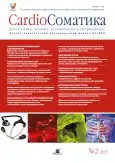Questions of secondary prevention and rehabilitation of patients with myocardial infarction at different stages
- Authors: Kuimov A.D1, Shurkevich A.A2, Moskalenko I.V3
-
Affiliations:
- Novosibirsk State Medical University
- City clinical hospital №2
- City clinical hospital №19
- Issue: Vol 6, No 2 (2015)
- Pages: 20-25
- Section: Articles
- URL: https://journals.rcsi.science/2221-7185/article/view/45117
- DOI: https://doi.org/10.26442/CS45117
- ID: 45117
Cite item
Full Text
Abstract
Full Text
##article.viewOnOriginalSite##About the authors
A. D Kuimov
Novosibirsk State Medical Universityд-р мед. наук, проф., зав. каф. факультетской терапии ГБОУ ВПО НГМУ 630091, Russian Federation, Novosibirsk, ul. Krasnyi prospekt, d. 52
A. A Shurkevich
City clinical hospital №2
Email: shurkevich@mail.ru
врач-кардиолог ГБУЗ НСО ГКБ №2 630051, Russian Federation, Novosibirsk, ul. Polzunova, d. 21
I. V Moskalenko
City clinical hospital №19врач-кардиолог, зав. отд-нием восстановительного лечения ГБУЗ НСО ГКБ №19 630038, Russian Federation, Novosibirsk, ul. Shukshina, d. 3
References
- Антипова С.И., Антипов В.В. Болезни системы кровообращения: эпидемиологические и демографические сопоставления. Мед. новости. 2011; 12: 37-43.
- Гаас Г.Н., Модестов А.А. Особенности заболеваемости населения трудоспособного возраста болезнями системы кровообращения по данным ОМС. Соц. аспекты здоровья населения. 2011; 17 (1).
- European Actionon Secondary Prevention by Intervention to Reduce Events, 2001.
- Оганов Р.Г., Калинина А.М., Концевая А.В. Экономический ущерб от сердечно - сосудистых заболеваний в Российской Федерации. Кардиоваск. терапия. 2011; 4: 4-9.
- Maron D.J, Spertus J.A, Mancini G.B.J et al. Impact of an initial strategy of medical therapy without percutaneous coronary intervention in high - risk patients from the Clinical Outcomes Utilizing Revascularization and Aggressive druG Evaluation (COURAGE) trial. Am J Cardiol 2009.
- Куимов А.Д., Якобсон Г.С. Инфаркт миокарда: клинические и патофизиологические аспекты. Новосибирск: НГУ, 1992.
- Бабунашвили А.М., Иванов В.А., Дундуа Д.П. и др. Лечение коронарного атеросклероза: влияние массового применения стентов на ближайшие и отдаленные результаты коронарной ангиопластики. Кардиология. 2004; 5: 23-9.
- Никитин Ю.П. Новые фундаментальные и прикладные основы атерогенеза. Бюлллетень СО РАМН. 2006; 2: 6-14.
- Николаева Л.Ф., Аронов Д.М. Реабилитация больных ишемической болезнью сердца. М.: Медицина, 1988.
- Оганов Р.Г. Профилактика сердечно - сосудистых заболеваний: возможности практического здравоохранения. Кардиоваск. терапия и профилактика. 2002; 1: 5-9.
- Оганов Р.Г., Марцевич С.Ю. Лекарственная терапия сердечно - сосудистых заболеваний: данные доказательной медицины и реальная клиническая практика. Рос. кардиол. журн. 2001; 4: 8-11.
Supplementary files







